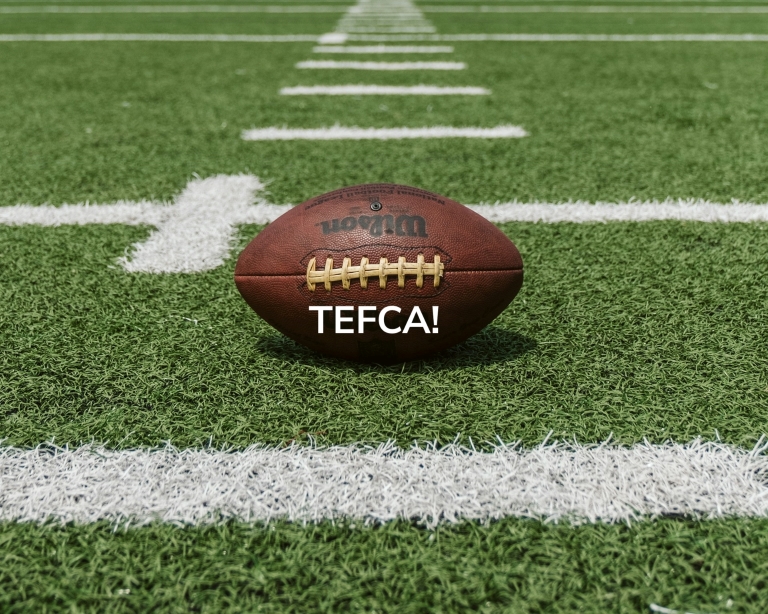How to teach a football fan about TEFCA

It's hard to follow the Super Bowl. 113 million people don't tune in to just any live event. (To my chagrin, nor do such masses read blogs about interoperability.) Thus, you're forgiven if you missed Monday morning's extravaganza, at which HHS announced the first prospective QHINs under TEFCA. In fact, you're forgiven if you don't know what the heck TEFCA is, why anyone would want to be a QHIN, and if it will have any bearing on your next trip to urgent care.
At Monday's event, HHS Secretary Xavier Becerra claimed the announcement was "more consequential than yesterday's game." Many Kansas City fans would disagree, but there's no denying we've begun a new chapter for interoperability. And perhaps surprisingly, football can help even the most casual observer of health IT understand what's going on and why it's important.
So whether you're a die-hard fan or you just know someone lucky enough to catch the game-winning ball, here's a primer on TEFCA that'll work from the gridiron to the gynecology clinic.
The opening kick
TEFCA is the Trusted Exchange Framework and Common Agreement, and you can thank Congress for it. The 21st Century Cures Act, passed in 2016, directed HHS to create TEFCA in order to promote greater, more efficient healthcare data exchange throughout the US (search for "Sec. 4003" within the bill's text). However, Congress specified that participating in TEFCA is strictly voluntary.
The current playing field
Imagine a world with professional football teams but no NFL or standardized rule book. When the Titans play the Steelers in Week 1, they must negotiate over things like the length of each quarter, how many players are allowed on each team, and how many timeouts both sides get. Then when the Titans play the Cowboys in Week 2, they must negotiate again over the same things, and the rules for this second game may differ from the first one's.
Exchanging data in healthcare is like that today. Its fragmented nature means you often have to establish point-to-point connections with individual providers, payers, etc. Need to send lab orders and receive results from three different reference labs? You'll have to build separate interfaces for each, and there is variation in how you establish those connections, what information you must provide to get the data you seek, and for what purposes you are allowed to request and receive data.
The Xs and Os
The TEF part in TEFCA is the shorter, more general portion. It's a set of non-binding principles that health information networks should follow to achieve that aforementioned goal of strong, efficient interoperability. In football, it's common practice to shake hands after a game and to remove your helmet before doing so. Neither action is required in the rule book, but these are shared principles that make for good sportsmanship and build a sense of respect among competitors. Likewise, the TEF encourages HINs to follow certain best practices, such as using industry standards rather than proprietary ones and making their privacy policies publicly accessible, for the sake of strong, efficient interoperability.
The CA part is a legal agreement, so it is more detailed and is legally binding. Think of this like the bylaws for a league. When an expansion team joins the NFL, they are agreeing to follow this set of rules, and there are consequences if they break any rules. The CA and its associated standard operating procedures outline rules that HINs must follow, such as only exchanging data for a valid purpose like treatment-payment-operations and carrying a minimum amount of cybersecurity insurance, to ensure they are participating in TEFCA correctly and fairly.
Winners and QHIN-ers
A Qualified Health Information Network (QHIN) is simply a health information network (i.e., a repository of health data across a large population) that has signed the Common Agreement and is participating in TEFCA. Not just anyone can become a QHIN; an organization must meet the criteria, apply, and be approved as a prospective QHIN. That is where we are today; Monday's event simply announced the first six organizations to have their applications approved. After this, the prospective QHINs must sign the Common Agreement and complete an extensive onboarding process before becoming fully designated QHINs.
Who's calling the plays?
The ONC saw the need for a partner to manage and support several aspects of TEFCA, so it underwent a competitive process to draft a Recognized Coordinating Entity (RCE). The Sequoia Project is the current RCE and is on point for, among other things, engaging with the health IT community and monitoring the designated QHINs. It's important to note that the ONC hasn't punted away all of its responsibility and authority. They've simply hired a league commissioner to manage the key operational tasks like establishing the rules for the league's teams, onboarding new teams into the league, and making sure things are running smoothly. The ONC has allocated $5.1 million to The Sequoia Project for serving as the RCE over four years, ending just before the start of the next NFL season.
Must-see TV
What's the practical impact of all this? Earlier, I gave the example of lab interfaces to highlight the fragmented nature of healthcare interoperability. While a very real scenario, I have to admit that was a bit of a hook and ladder. Not all healthcare data exchange relies on singular connections with individual software systems.
There are health information exchanges and other entities that aggregate large amounts of data across an entire population, so you can get a more comprehensive set of data this way. Examples include CRISP in Maryland, Big Sky Care Connect in Montana, and implementers of the Carequality framework. If you need to make a trip to urgent care and that location participates in an HIE, they should be able to pull your medical data from other HIE participants to have a more comprehensive view of your clinical history.
But these HIEs don't necessarily talk to each other well, so if the data that urgent care needs lives with two different HIEs, they would have needed to establish separate connections and conform to separate rules. In the NFL, this would be like if the AFC and NFC had different rules, so playing a team within your conference is a lot easier than playing one without. Instead, the NFL says "No matter where your team is located or which conference it is in, here are the rules every team will follow."
TEFCA aims to do the same thing, allowing any requester within a participating QHIN to get the data it needs from any other source within any QHIN. The hope is that standardizing the rules for data exchange will make it easier for patients, providers, researchers, and others to request and retrieve medical information, to improve care delivery, and to make us healthier. Will TEFCA solve all of our interoperability woes? Absolutely not, but it will take us a bit further downfield.
---
Photo by Dave Adamson on Unsplash



